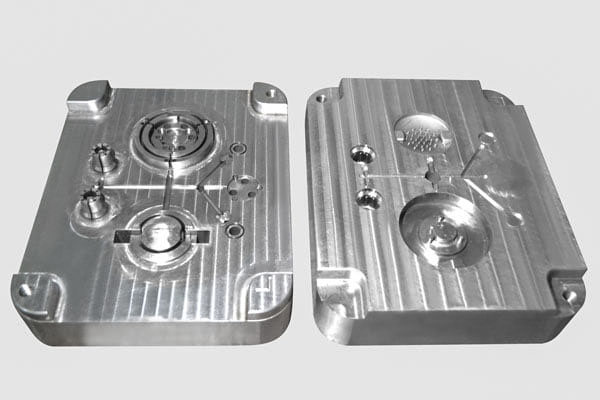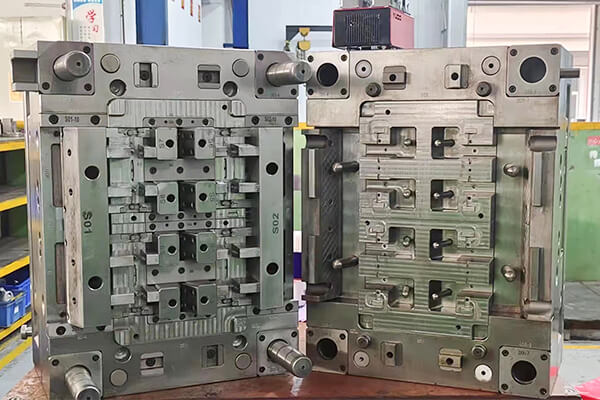Steel Molds vs Aluminum Molds for Injection Molding
Aluminum molds for injection molding or steel tools make up the majority of molds, always involving aluminum and steel processing techniques. According to conventional belief, aluminum is more affordable for low volume or small batch quantities whereas steel molds are more costly. That isn’t always the case, though, if you decide to choose us for your upcoming injection molding project. Different steel and aluminum alloys have significant variances from one another, and building a mold might include several steps that impact its price.
At Sungplastic, we can help to make the best aluminum prototype molds and steel molds for your projects.

Important Considerations
When designing a part for plastic injection molding, there are two fundamental questions you should address:
Tool Longevity: How long do you expect the new tool to remain in service before requiring replacement or refurbishment?
Production Volume: What is the anticipated annual production volume for the parts to be manufactured with the tool?
Obtaining answers to these questions is crucial before committing to the significant investment associated with a steel or aluminum injection molding tool. Not having a clear understanding of these aspects can potentially lead to unexpected costs and complications. We are here to provide valuable assistance in this regard. Our team of design for manufacturing (DFM) experts possesses extensive knowledge in steel and aluminum injection molding and can help you optimize your tooling to suit your specific requirements. Keep in mind that what might initially appear as a cost-effective option could result in higher expenses in the long run, particularly if you lack experience with steel or aluminum injection molding tools, face the need for tool replacement, or encounter quality issues with the produced parts.
Selecting between steel and aluminum injection molding involves several important factors. We will delve into these factors, including material hardness, machining capabilities, welding, processing considerations, mold inserts, and the expected lifespan of the tool.
A Brief Overview of Steel vs. Aluminum Molds
Historically, throughout the majority of the twentieth century, steel molds were the preferred choice in the manufacturing industry. However, in the 1990s, the global steel industry encountered significant challenges, including a structural crisis stemming from shifts in steelmaking locations. Simultaneously, advancements in aluminum metallurgy offered a cost-effective alternative to steel molds. This transition was supported by major players like Honda America, which encouraged its Tier One suppliers to employ aluminum molds for production parts.
In the early 2000s, China emerged as the world’s leading steel producer, partially due to government subsidies. These subsidies led to overproduction and subsequent decreases in steel prices. While Chinese steel production has slowed more recently, competitive prices persist, especially due to Western sanctions affecting Russian steel. The top steel-producing nations now include China, Japan, the United States, and Germany.

Alloys and Hardness
All countries employ similar steelmaking processes, but variations exist in steel characteristics based on their alloy compositions. German steels tend to be harder, Japanese steels offer greater flexibility due to their alloying elements, and Chinese steels encompass diverse grades compared to U.S. steels.
Tool steels are the primary choice for mold materials, with a supplementary role for stainless steel in mold bases. Rockwell hardness, a measure of resistance to indentation, serves as a standardized metric for comparing steels and other metals utilized in injection molds, such as aluminum.
It’s essential to note that steel is generally harder than aluminum in injection molding. However, specific grades of steel may not endure the higher pressures generated by more potent injection molding machines. The hardness of a mold is a critical factor, as harder surfaces enable better polishing, finer part finishes, and greater resistance to wear and abrasion. When selecting the material for your injection molding tool, it’s useful to categorize steels into soft and semi-hardened varieties (e.g., P20 and NAK80) and hardened steels (e.g., H13 and S136), taking into account their intended applications and hardness characteristics.
Comparison of EDM Machining and CNC Machining
In our mold manufacturing process, we utilize both electrical discharge machining (EDM) and computerized numerical control (CNC) machining techniques. EDM, powered by electrical discharges or sparks, employs two primary methods: wire EDM and sinker EDM, while CNC machining uses precision cutting tools to remove material.
EDM machining is a preferred choice when your project demands sharp internal corners or extensive cuts. It excels in crafting intricate, deep features. This method is particularly effective for working with hard materials, such as tool steels, and when creating injection molds requiring a mirror-like finish. However, it’s not suitable for areas where heat-affected zones (HAZ) are a concern, such as welding points, and it tends to be slower than CNC machining. Sinker EDM, a subtype, is often employed for crafting injection molds as it avoids introducing stress into the mold material.
Conversely, CNC machining offers speed and versatility, with the capability to tackle complex geometries using 5-axis or greater CNC mills. This method is highly recommended for molds featuring ribs, despite the inherent challenges, such as tool deflection and breakage. When comparing costs, it’s vital to consider the specific EDM or CNC technique that will be applied. While conventional machining still finds utility in some injection molds, it’s typically reserved for smaller tasks or mold refurbishments.
Considerations for Machining, Welding, and Processing
Aluminum, as a material, offers advantages in machining efficiency when compared to steel. It allows for swifter and more cost-effective machining and polishing of molds, thereby reducing machine time – a critical cost driver in mold production. The machining rates for aluminum in CNC machining are three to ten times faster than for steel, contingent on the aluminum alloy used. EDM machining, on the other hand, is generally four to five times faster when working with aluminum, thanks to its high electrical conductivity. Additionally, aluminum injection molding supports simplified and cost-effective cooling systems for injection molds due to its superior thermal conductivity.
However, when welding is necessary, aluminum’s excellent thermal conductivity requires higher heat inputs due to increased heat dissipation. Welding aluminum is typically considered more challenging than steel welding, demanding greater skill and meticulous surface preparation. Moreover, certain aluminum grades are more difficult to weld than others. Welding may be required for insert sections in new molds and is typically applied to parting lines and gates during mold repairs.
Aluminum’s material properties also have implications for material selection, part volumes, and temperature control. Its relatively soft nature renders it unsuitable for abrasive plastics like glass-filled nylon. Aluminum tends to wear more quickly than steel, making steel a more suitable choice for high part volumes. Steel, with its superior thermal conductivity, excels in maintaining consistent heat levels during prolonged production runs, a critical factor in preventing issues such as shrinking and warping in plastic injection molding.
Standalone Molds vs. MUD Inserts
Injection molds typically consist of a core and a cavity, essential components held together within a machine or press by metal plates and additional mold elements. The core, which houses the part ejection mechanism, is the raised part of the mold, while the cavity is the recessed portion filled with molten plastic. While both core and cavity are vital in any injection molding project, part designers must choose between standalone molds and MUD (master unit die) inserts.
Standalone molds encompass not only the core and cavity but also all other necessary tooling components required for plastic injection molding. These additional elements drive up tooling costs, but they provide the flexibility to accommodate larger part sizes, limited only by the injection mold’s size that the machine or press can support.
In contrast, MUD inserts, or universal frames, fit into the press and accommodate removable inserts. They offer cost savings in machining, as cutting is required only for the removable core and cavity. A single MUD frame can accept various inserts, potentially allowing the reuse of existing frames for new projects. However, the part size is constrained by the frame’s dimensions. MUD inserts help minimize upfront tooling expenses and expedite project timelines.
Crucially, MUD frames can make steel inserts cost-competitive with standalone aluminum injection molding molds, facilitating the use of steel tooling in prototyping and low-volume injection molding. This dispels the misconception that steel molds are invariably more expensive. Additionally, aluminum alloy inserts, including 7075 aluminum, are an alternative. QC-10 high-strength aluminum mold plate and 6061 aluminum can also be employed for low-volume bridge tools.
Tool Life
In the world of injection molds, tool life is not measured in years but in cycles. The onset of mold wear and the need for replacement or refurbishment may be evident long before the quoted “tool life” limit is reached. Therefore, proper mold maintenance and steel or aluminum injection molding practices are essential, as is an understanding of part design.
Draft, a taper applied to the faces of an injection-molded part, is critical for preventing damage during ejection and reducing wear on the mold itself. Material selection is another influential factor in tool wear. For instance, super-high-heat thermoplastics like PEEK, with their high melting points, induce more compressive stresses on molds due to metal expansion with heat. Elevated temperatures can also expedite the deterioration of lubricants used in mold moving parts.
Contrary to popular belief, steel tooling isn’t invariably more costly, and aluminum tools are not strictly limited to a maximum of 10,000 shots. With proper mold construction and optimal injection molding conditions, a tool can endure anywhere from 50,000 to 100,000 cycles.
Custom Steel and Aluminum Molds for Injection Molding Project
When you’re ready to start your next steel and aluminum injection molding project, contact us so we can provide you with an estimate and a professional DFM analysis. Our team will offer insightful advice and helpful design insights to help build the perfect tooling to meet the particular needs of your project.
We are always here to help with your vital projects!
Get a free quote and design analysis today.
We’ll reply to you within 6 working hours.
We respect your privacy.
+86 139 2927 4777 (WhatsApp, Wechat)
